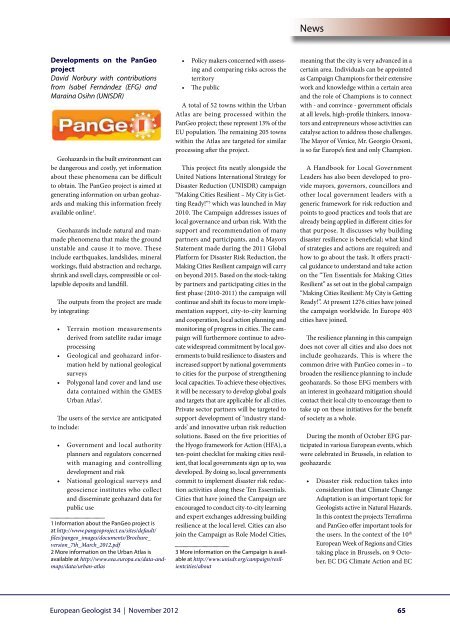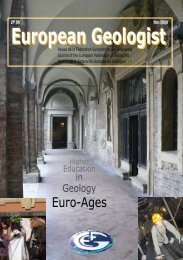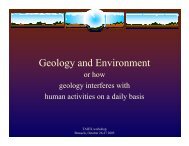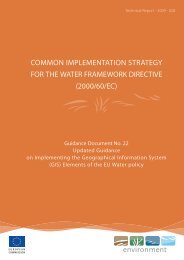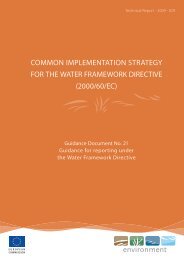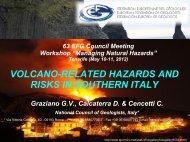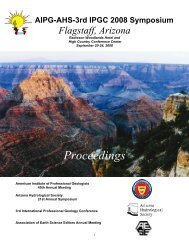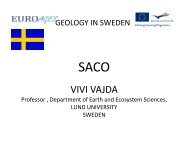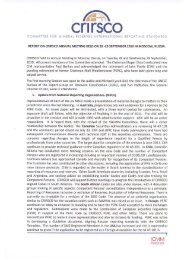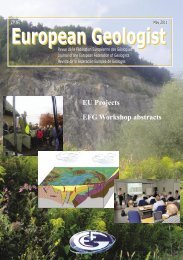European Geologist European Geologist Geoheritage - learning ...
European Geologist European Geologist Geoheritage - learning ...
European Geologist European Geologist Geoheritage - learning ...
You also want an ePaper? Increase the reach of your titles
YUMPU automatically turns print PDFs into web optimized ePapers that Google loves.
News<br />
Developments on the PanGeo<br />
project<br />
David Norbury with contributions<br />
from Isabel Fernández (EFG) and<br />
Maraina Osihn (UNISDR)<br />
Geohazards in the built environment can<br />
be dangerous and costly, yet information<br />
about these phenomena can be difficult<br />
to obtain. The PanGeo project is aimed at<br />
generating information on urban geohazards<br />
and making this information freely<br />
available online 1 .<br />
Geohazards include natural and manmade<br />
phenomena that make the ground<br />
unstable and cause it to move. These<br />
include earthquakes, landslides, mineral<br />
workings, fluid abstraction and recharge,<br />
shrink and swell clays, compressible or collapsible<br />
deposits and landfill.<br />
The outputs from the project are made<br />
by integrating:<br />
• Terrain motion measurements<br />
derived from satellite radar image<br />
processing<br />
• Geological and geohazard information<br />
held by national geological<br />
surveys<br />
• Polygonal land cover and land use<br />
data contained within the GMES<br />
Urban Atlas 2 .<br />
The users of the service are anticipated<br />
to include:<br />
• Government and local authority<br />
planners and regulators concerned<br />
with managing and controlling<br />
development and risk<br />
• National geological surveys and<br />
geoscience institutes who collect<br />
and disseminate geohazard data for<br />
public use<br />
1 Information about the PanGeo project is<br />
at http://www.pangeoproject.eu/sites/default/<br />
files/pangeo_images/documents/Brochure_<br />
version_7th_March_2012.pdf<br />
2 More information on the Urban Atlas is<br />
available at http://www.eea.europa.eu/data-andmaps/data/urban-atlas<br />
• Policy makers concerned with assessing<br />
and comparing risks across the<br />
territory<br />
• The public<br />
A total of 52 towns within the Urban<br />
Atlas are being processed within the<br />
PanGeo project; these represent 13% of the<br />
EU population. The remaining 205 towns<br />
within the Atlas are targeted for similar<br />
processing after the project.<br />
This project fits neatly alongside the<br />
United Nations International Strategy for<br />
Disaster Reduction (UNISDR) campaign<br />
“Making Cities Resilient – My City is Getting<br />
Ready!” 3 which was launched in May<br />
2010. The Campaign addresses issues of<br />
local governance and urban risk. With the<br />
support and recommendation of many<br />
partners and participants, and a Mayors<br />
Statement made during the 2011 Global<br />
Platform for Disaster Risk Reduction, the<br />
Making Cities Resilient campaign will carry<br />
on beyond 2015. Based on the stock-taking<br />
by partners and participating cities in the<br />
first phase (2010-2011) the campaign will<br />
continue and shift its focus to more implementation<br />
support, city-to-city <strong>learning</strong><br />
and cooperation, local action planning and<br />
monitoring of progress in cities. The campaign<br />
will furthermore continue to advocate<br />
widespread commitment by local governments<br />
to build resilience to disasters and<br />
increased support by national governments<br />
to cities for the purpose of strengthening<br />
local capacities. To achieve these objectives,<br />
it will be necessary to develop global goals<br />
and targets that are applicable for all cities.<br />
Private sector partners will be targeted to<br />
support development of ‘industry standards’<br />
and innovative urban risk reduction<br />
solutions. Based on the five priorities of<br />
the Hyogo framework for Action (HFA), a<br />
ten-point checklist for making cities resilient,<br />
that local governments sign up to, was<br />
developed. By doing so, local governments<br />
commit to implement disaster risk reduction<br />
activities along these Ten Essentials.<br />
Cities that have joined the Campaign are<br />
encouraged to conduct city-to-city <strong>learning</strong><br />
and expert exchanges addressing building<br />
resilience at the local level. Cities can also<br />
join the Campaign as Role Model Cities,<br />
3 More information on the Campaign is available<br />
at http://www.unisdr.org/campaign/resilientcities/about<br />
meaning that the city is very advanced in a<br />
certain area. Individuals can be appointed<br />
as Campaign Champions for their extensive<br />
work and knowledge within a certain area<br />
and the role of Champions is to connect<br />
with - and convince - government officials<br />
at all levels, high-profile thinkers, innovators<br />
and entrepreneurs whose activities can<br />
catalyse action to address those challenges.<br />
The Mayor of Venice, Mr. Georgio Orsoni,<br />
is so far Europe’s first and only Champion.<br />
A Handbook for Local Government<br />
Leaders has also been developed to provide<br />
mayors, governors, councillors and<br />
other local government leaders with a<br />
generic framework for risk reduction and<br />
points to good practices and tools that are<br />
already being applied in different cities for<br />
that purpose. It discusses why building<br />
disaster resilience is beneficial; what kind<br />
of strategies and actions are required; and<br />
how to go about the task. It offers practical<br />
guidance to understand and take action<br />
on the “Ten Essentials for Making Cities<br />
Resilient” as set out in the global campaign<br />
“Making Cities Resilient: My City is Getting<br />
Ready!”. At present 1276 cities have joined<br />
the campaign worldwide. In Europe 403<br />
cities have joined.<br />
The resilience planning in this campaign<br />
does not cover all cities and also does not<br />
include geohazards. This is where the<br />
common drive with PanGeo comes in – to<br />
broaden the resilience planning to include<br />
geohazards. So those EFG members with<br />
an interest in geohazard mitigation should<br />
contact their local city to encourage them to<br />
take up on these initiatives for the benefit<br />
of society as a whole.<br />
During the month of October EFG participated<br />
in various <strong>European</strong> events, which<br />
were celebrated in Brussels, in relation to<br />
geohazards:<br />
• Disaster risk reduction takes into<br />
consideration that Climate Change<br />
Adaptation is an important topic for<br />
<strong>Geologist</strong>s active in Natural Hazards.<br />
In this context the projects Terrafirma<br />
and PanGeo offer important tools for<br />
the users. In the context of the 10 th<br />
<strong>European</strong> Week of Regions and Cities<br />
taking place in Brussels, on 9 October,<br />
EC DG Climate Action and EC<br />
<strong>European</strong> <strong>Geologist</strong> 34 | November 2012<br />
65


